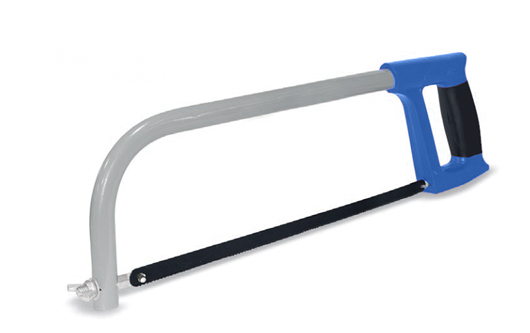Hacksaws (Download)
HACKSAWS 1 Description A hacksaw is a fine-toothed saw with a blade under tension in a frame. Used for cutting materials such as metal or bone. Standard Hacksaws 2 Hand-Held Hacksaws Consists of : metal arch and handle Pins (for attaching a narrow disposable blade) Screw (used to put thin blade under tension) Blade (can be installed to cut toward or away from handle) http://www.creativecrash.com/system/photos/000/061/377/61377/big/hacksaw02d_show2.jpg 3 Hand-Held Hacksaws (Blade) Blades are available in standardized lengths Available by tooth count. Choose blade based on: Thickness of material Min. of 3 teeth in material http://www.creativecrash.com/system/photos/000/061/376/61376/big/hacksaw02d_show.jpg 4 Panel Hacksaws Eliminates the frame Saw can cut into panels of sheet metal with no restriction from frame http://upload.wikimedia.org/wikipedia/commons/6/61/Panel_hacksaw.JPG 5 Power Hacksaws Type of hacksaw that is powered by electric motor. Stationary machine (mostly) Used in place of band saw for cutting metal stock to length Provides a cleaner cut http://upload.wikimedia.org/wikipedia/commons/c/c2/SawMachine.jpg 6 History Hacksaws were first fabricated in 1915. They were products first manufactured by Lenox. http://us.123rf.com/400wm/400/400/svlumagraphica/svlumagraphica0812/svlumagraphica081200058/3991708.jpg 7 Power Hacksaw Hazards Cuts Reciprocating blade Electrical Shock Noise 8 Hacksaw PPE Safety Gloves Safety Glasses Hearing Protection (if applicable) 9 Power Hacksaw Precautions always ensure the machine is switched off before making adjustments to the machine Beware of blade breakage Hazard check all guards are in position Ensure the vice and table are firmly locked before switching on the machine Do not wear loose clothing or jewelry 10 Power Hacksaw Precautions Hazard : adjust the feed speed before starting the machine Use cutting fluid Do not : wear gloves while operating this equipment Never attempt to cut non linear cuts 11 Hand-held Hacksaw Hazards Cutting hazard Twisting/breaking hazard Loose blade hazard 12 Hand-held Hacksaw Precautions Choose the right blade for the right job Coarse tooth blades make for faster work Finer blades are needed for cutting thinner metal Use a vice to secure metal to be cut Move the body forward and back as a cut is made 13 Hand-held Hacksaw Precautions Use long even strokes Do not put too much pressure on blade When the cut is nearly complete, ease up to prevent the severed section from causing harm. Clean and store saw appropriately after use 14 Injury Statistics Name of study: “Occupational injuries among construction workers treated in major metropolitan emergency department in the United States.” By: Laura S Welch, MD, Katherine L Hunting, PHD, Judith Anderson Marawski, MSc 15 Study Objective Objective: The aim of this study was to profile construction worker injuries for more information about causes of nonfatal injuries and to identify injury trends for further investigations and prevention programs. Scand J Work Environ Health 2005; 31 suppl 2:11-21 16 Injury Statistics Results Injuries from sharp objects posed the most worker injuries in this study Scand J Work Environ Health 2005; 31 suppl 2:11-21 17 Injury Statistics Results Injury from sharp objects was the number 1 ranked source of injury 26% of construction workers studied were injured by a sharp object There were 12 incidents of injuries related to HACKSAWS Scand J Work Environ Health 2005; 31 suppl 2:11-21 18 Osha regulations 1926.301 Hand tools 1926.302 Power-operated hand tools 19 Safety Procedures Use the right blade for the right job Use a vice to secure metal to be cut Move the body forward and back as a cut is made Use long even strokes 20 Safety Procedures Do not put too much pressure on blade When the cut is nearly complete, ease up to prevent the severed section from causing harm. Clean and store saw appropriately after use If using a Power Hacksaw, do not cut round stock 21 Think Safety Work Safely 22

